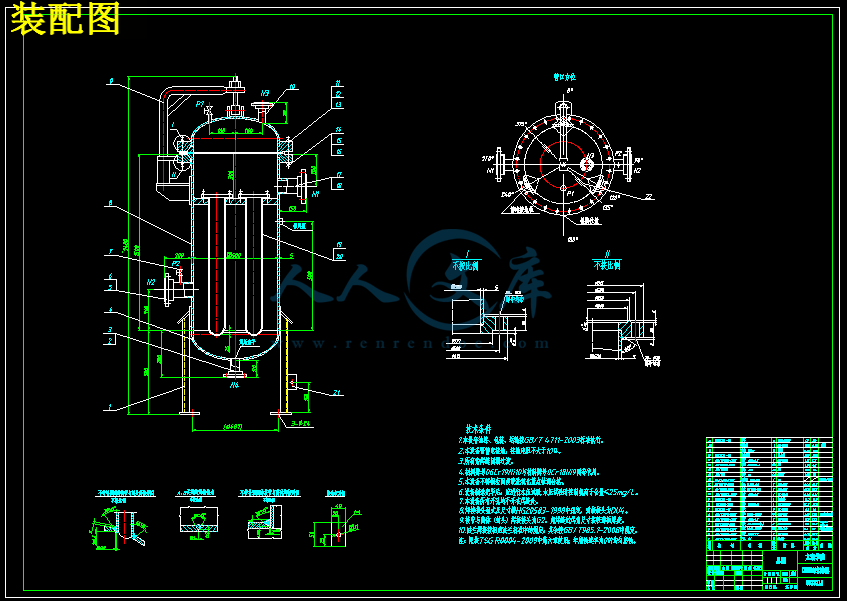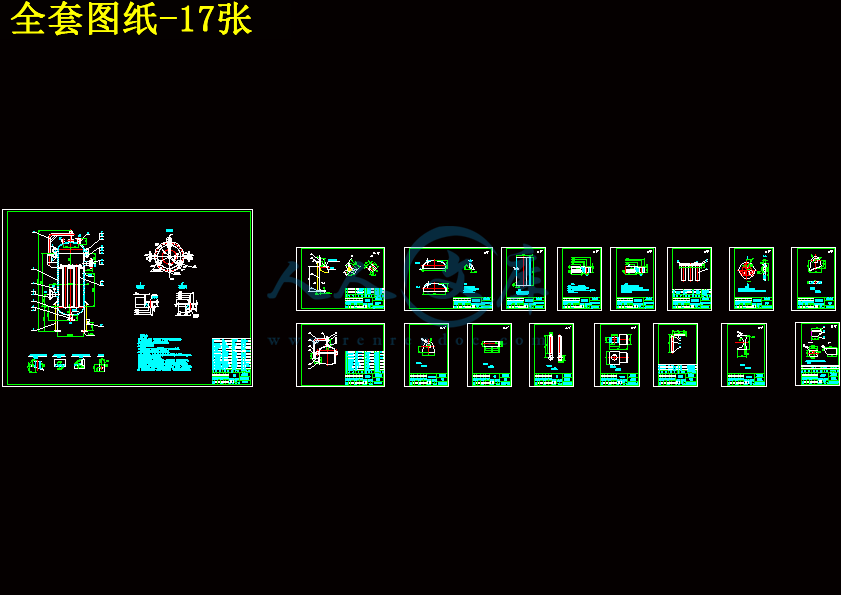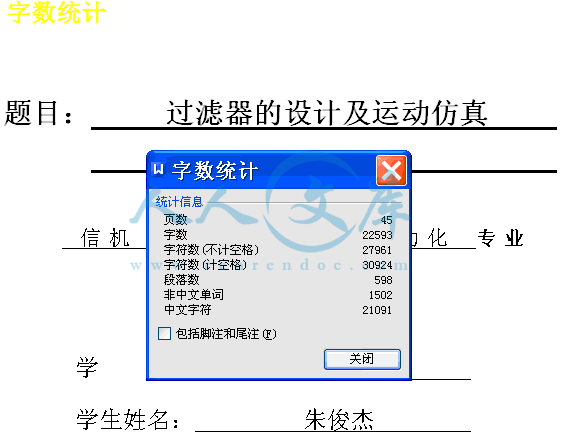摘 要
过滤分离技术在国民经济各个部门中应用很广。从人民日常生活,资源、能源的开发利用,国防尖端,到保护环境,防止公害等方面,都离不开过滤分离技术。过滤器和过滤分离技术不仅应用广,而且是某些生产过程中的关键性设备之一,若采用不当,不但生产任务完不成,产品质量上不去,而且会造成资源浪费,环境污染,使整个生产经济效益很低。因此,必须根据物料的种类及生产上的要求,研究、设计和制造各种不同系列、规格和型号的过滤器,以适应各种不同生产的需要。
本设计选择复合型袋式精细过滤器作为设计对象。在全面了解过滤器的结构及其工作原理后,运用SW6-1998过程设备强度计算软件,对受压的圆筒、封头和法兰等受压元件进行强度计算。利用UG软件对过滤器的零件进行参数化建模,并对整体结构进行虚拟装配。然后将装配体导入UG软件的运动仿真界面,并利用软件进行运动学仿真。分析仿真结果,得出相应结论。最后对过滤器进行优化设计,提高其稳定性,可靠性,让本设计能够真正的投入到日常生产操作中,使其切实能够为过滤分离技术做出贡献。
关键词:UG;过滤器;运动仿真
Abstract
Filtering separation technology is applied widely in various departments of national economy. From the aspect of people’s daily life, such as the exploitation and utilization of resources and energy and the advanced national defense to the aspect of protecting environment and preventing pollution and other aspects, all of them cannot be without filtration-separation technology . Filter and filtering-separation technology are not only used widely but also are one of the key equipments in some production processes. If the technology is used unsuitably, the production task will not be finished and the quality of the products will not be improved. Even it will cause the the waste of resources and environmental pollution so that it will reduce the production efficiency.Therefore, in order to meet the demands of different production, we should research, design and manufacture the various series, specifications and types of filters according to the kinds of production materials and the requirements of production.
This design chooses fine the composite bag type filter as the design object. After comprehensive understanding of the structure and working principles of the filter, this design uses SW6-1998 process equipment calculation software for calculating the strength of the pressurized cylinder, head, and flange pressure parts and other pressurized parts. This design has a parametric modeling of the elements of filter by using UG software and assemble the integral structure virtually. Then the design will lead the assembly into the motion simulation interface of the UG software and use the software to make kinematics simulation. Next we should make analysis of the simulation results and obtain the corresponding conclusions. Finally we should do the optimization design to improve the stability and reliability of the filter in order to put this design into the daily production operation really and make contributions faithfully to the filtration-separation technology.
Key words: UG ; Filter ; Motion simulation
目 录
摘 要 III
Abstract IV
目 录 V
1 绪论 1
1.1 过滤器设计的目的和意义 1
1.2 过滤器的发展 1
1.3 过滤器的未来展望 2
1.4 本文的基本构想与要求 3
2 过滤器总体设计方案 4
2.1 过滤器设计概述 4
2.1.1 过滤器简介 4
2.1.2 过滤器结构 4
2.1.3 过滤器工作原理 4
2.1.4 过滤器有关设计参数 4
2.2 过滤器的特征 4
2.2.1 主要特征 4
2.2.2 安装步骤 5
2.2.3 应用 5
2.3 过滤器的参数计算 5
2.3.1 内筒体内压计算 5
2.3.2 内筒封头内压计算 6
2.3.3 法兰计算 7
2.3.4 开口补强计算 9
2.4 过滤器部件设计 10
2.4.1 封头设计 10
2.4.2 法兰设计 11
2.4.3 摇臂式吊杆设计 13
2.4.4 筒体设计 13
2.4.5 复合滤筒设计 15
2.4.6 支座组件设计 15
3 SW6-98软件的应用 17
3.1 SW-98软件介绍 17
3.2 SW6-98软件结构及一般使用指南 18
3.3 SW6-98软件的使用 19
3.3.1 软件模块计算项目 19
3.3.2 软件计算校核 19
4 UG软件的应用 23
4.1 UG软件介绍 23
4.2 UG功能与优点 23
4.3 UG主要功能模块 24
4.4 过滤器运动仿真分析 26
5 结论与展望 33
5.1 结论 33
5.2 不足之处及未来展望 33
致 谢 34
参考文献 35
1 绪论
1.1 过滤器设计的目的和意义
目前,我国很多企业使用传统过滤器,这种过滤器在过滤持续过程中,过滤面积小使得液体中固态杂质被过滤元件表面,过滤效率下降。因此需要对此装置进行改进与创新,提高使用周期,减少停车次数,能够提高生产产量和产品质量。复合型袋式精细过滤器与普通过滤器相比,在同样壳体、容积的情况下,该过滤器过滤面积相对大60%以上,这样装置运行周期长,停车时间短,有效降低运行成本;在相同处理量的情况下,该过滤器过滤面积较普通过滤器大,意味着设备容积就可以做小,可以节省设备投资20%以上,有效降低设备的制造成本。
1.2 过滤器的发展
过滤器的原型是人们为保护呼吸而使用的呼吸保护器具[1]。据记载,早在一世纪的罗马,人们在提纯水银的时候就用粗麻制成的面具进行保护。在此之后的漫长时间里,空气过滤器也取得了进展,但其主要是作为呼吸保护器具用于一些危险的行业,如有害化学品的生产。1827年布朗发现了微小粒子的运动规律,人们对空气过滤的机理有了进一步的认识。
过滤器的迅速发展是与军事工业和电子工业的发展紧密相关的。在第一次世界大战期间,由于各种化学毒剂的使用,以石棉纤维过滤纸作为滤烟层的军用防毒面具应运而生。玻璃纤维过滤介质用于空气过滤于1940年10月在美国取得专利。50年代,美国对玻璃纤维过滤纸的生产工艺进行了深入的研究,使空气过滤器得到了改善和发展。60年代,HEPA过滤器问世;70年代,采用微细玻璃纤维过滤纸作为过滤介质的HEPA过滤器,对0.1微米粒径的粒子过滤效率高达99.9998%。八十年代以来,随着新的测试方法的出现、使用评价的提高及对过滤性能要求的提高,发现HEPA过滤器存在着严重的问题,于是又产生了性能更高的ULPA过滤器。目前,各国仍在努力研究,估计不久就会出现更先进的空气过滤器。
过滤器本身的设计也取得了显著进展,其中最重要的是分隔板的去除,即无隔板过滤器的发展。无隔板过滤器不仅消除了分隔板损坏过滤介质的危险,而且有效地增加了过滤面积,提高了过滤效率,并降低了气流阻力,从而减少了能量消耗。此外,空气过滤器在耐高温、耐腐蚀以及防水、防菌等方面也取很大的进展,满足了一些特殊的需求。
70年代前后是精密过滤器飞跃发展时期,美、英、德、法和日本都有自己牌号的精密过滤器,并纷纷在国际市场上竞争。影响最大的是美国公司,其次是德国公司,他们分布于世界各地,从事精密过滤器滤膜和精密过滤器滤器的生产,科研和销售等工作。
六十年代,我国一些科研部门对精密过滤器进行了小规模的试验和应用,但基本上没有形成工业规模的生产能力。70年代末期,上海医药工业研究院等单位对精密过滤器进行了教系统的研究。迄今为止,国内已有了商品化的精密过滤器,其中生产最多的品种是混合纤维素滤膜。耐溶剂、耐温和耐酸碱等方面的滤膜——特种多孔滤膜已被研制和先后投产的有聚砜酰胺精密过滤器膜、N型聚酰胺精密过滤器膜、聚四氟乙烯精密过滤器膜、核孔膜及其他优质精密过滤器滤膜等。
至于精密过滤器的形式,除板式以外,还制成了摺叠式筒型,可谓品种繁多、五花八门,基本已满足了国内各方面的需要。当然和国外相比,我国的产品无论是在质量方面还是在数量方面,都还存在一定的差距,有待进一步的提高和创新。
精密过滤器主要用于分离各种流体中尺寸为0.1-10μm的微生物和微粒子。在实验室中,精密过滤器过滤时检查有形微细杂质的重要工具。主要用途如下:
1、用于微生物检测,例如对饮用水中大肠菌群、游泳池水中假单胞族菌和链球菌、啤酒中酵母和细菌,软饮料中酵母、医药制品中细菌的检测和空气中微生物的检测等。
2、用于微粒子检测,例如对注射剂中不溶性异物、石棉粉尘,航空染料中的微粒子,水中悬浮和排气中粉尘的检测,锅炉用水中铁分的分析及放射性尘埃的采样等。
在流体净化、分离杂质、贵重物料回收等领域取得了最大的工艺效益和经济效益,被广泛应用于石油化工、精细化工、化纤工业、制药工业及航空、电子、食品、饮料等行业。













 川公网安备: 51019002004831号
川公网安备: 51019002004831号